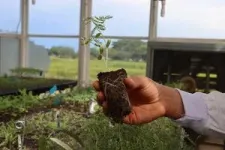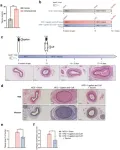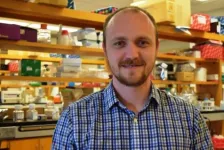(Press-News.org) The most advanced respirometry chambers in Latin America were inaugurated at the Alliance Bioversity-CIAT campus in Colombia. These are hermetically sealed spaces designed to precisely measure and analyze the concentrations of gases, such as methane and carbon dioxide, produced by animals.
This advance is part of the Low-Methane Forages, project led by the Alliance Bioversity-CIAT in collaboration with the CGIAR research centers ILRI and ICARDA and their Germplasm Banks.
The project is evaluating thousands of forage accessions to identify natural plant compounds with anti-methanogenic properties, meaning compounds capable of reducing methane production in the animals that consume them, thereby promoting a more sustainable approach to livestock farming.
Palmira, Valle del Cauca, October 25, 2024. The livestock sector in regions like Latin America and Africa plays a crucial role in the economy and food security. However, it also faces the challenge of adapting to climate change and mitigating its impact. One of the nature-based solutions lies in forages, which, in addition to being the primary source of livestock feed, when well-managed, have the potential to generate environmental and socio-economic benefits, such as soil carbon accumulation, biodiversity conservation, efficient water use, and increased income for small-scale producers.
Forage biodiversity includes a wide variety of plants for animal feed (grasses, shrubs, and legumes) that have been the subject of research to improve their adaptability to abiotic stress factors (drought, flooding, acidic soil), and resistance to pests and diseases, while maintaining high nutritional value for livestock. However, a new possibility has emerged: the composition (naturally occurring compounds) of certain forages can significantly reduce methane emissions from livestock.
With this approach, an innovative research project for development of Low-Methane Forages has been launched, supported by the Bezos Earth Fund and the Bill and Melinda Gates Foundation and in coordination with the Global Methane Hub. This project aims to contribute to a 1.5% reduction in global enteric methane emissions by 2030.
The project is currently in its first phase of “Discovery,” which seeks to identify the anti- methanogenic compounds (AMC) of forage diversity accessions from the CGIAR Research Centers' germplasm banks, evaluating approximately 6,000 of the 71,000 forage accessions available. The process involves both in vitro (in the laboratory) and in vivo (using live animals) trials, the latter being a key methodology, as it allows for the integration of the animal component in the early stages of research, which is critical for making informed decisions in the scaling phase.
"Biodiversity has often been the key to overcoming the challenges humanity has faced throughout the agricultural era. With this project, we aim to tap into the rich diversity of forages stored in CGIAR’s genebanks for their potential to reduce enteric methane emissions". Jacobo Arango, Senior Scientist of the Alliance Bioversity-CIAT and Principal Investigator of the Low-Methane Forages Project.
As part of the “Discovery” phase, the most advanced respirometric facility in Latin America has been inaugurated at the Alliance Bioversity-CIAT campus. These chambers will be essential for in vivo validation of the forage accessions with the greatest capacity to reduce methane emissions. Comprising 16 chambers, 8 for sheep and 8 for cattle, this research facility is one of the most advanced in the region for accurately measuring methane and carbon dioxide emissions from livestock in real-time. Its state-of-the-art technology allows for precise monitoring of gas concentrations derived from different dietary options, while its airtight and controlled environment maintains constant temperature, humidity, and airflow, simulating real conditions for future scaling studies in the livestock sector.
“You know the saying 'you can’t manage what you can’t measure' and that really applies with livestock. It’s tough to get a clear picture of how much emissions come from a single animal. That’s why this new infrastructure is so important and opens so many doors for us to understand emissions better and figure out how to reduce them”. Andy Jarvis, Director of Future of Food, Bezos Earth Fund
This infrastructure strengthens the leadership of the Alliance Bioversity-CIAT in methane mitigation research and environmental sustainability in Latin America, reinforcing its commitment to innovation in sustainable livestock solutions. Furthermore, it reflects the organization's dedication to bringing the science developed at the research center to producers in the field, expanding the impact of these solutions in the livestock sector.
END
Alliance Bioversity-CIAT inaugurates the most advanced respirometry chambers in Latin America to measure methane emissions from livestock
2024-10-25
ELSE PRESS RELEASES FROM THIS DATE:
Study finds bariatric surgery declined with rise in GLP-1 drugs to treat obesity
2024-10-25
Researchers from Mass General Brigham and collaborators found that use of GLP-1 drugs to treat obesity more than doubled from 2022 to 2023 while rates of surgery dropped by one quarter.
KEY TAKEAWAYS
Researchers from Mass General Brigham and collaborators assessed national trends in the number of patients with obesity prescribed GLP-1 drugs and the number who underwent metabolic bariatric surgery.
Researchers documented a 132.6% increase in patients prescribed GLP-1 drugs between 2022 and 2023, and a 25.6% decrease in patients undergoing bariatric ...
UMD researcher trains AI to predict diarrheal outbreaks related to climate change
2024-10-25
Climate change-related extreme weather, such as massive flooding and prolonged drought, often result in dangerous outbreaks of diarrheal diseases particularly in less developed countries, where diarrheal diseases is the third leading cause of death among young children. Now a study out Oct. 22, 2024, in Environmental Research Letters by an international team of investigators led by senior author from University of Maryland’s School of Public Health (UMD SPH) Amir Sapkota, offers a way to predict the risk of such deadly outbreaks ...
Researchers discover that errors in protein location are a common cause of disease
2024-10-25
The team developed a high-throughput imaging platform to assess the influence of nearly 3,500 mutations on protein location. They found that roughly one in six disease-causing mutations led to proteins ending up in the wrong location in the cell.
“Technological advances in genetic sequencing have allowed researchers to identify thousands of protein mutations that cause disease,” said Jessica Lacoste, co-lead author on the study and postdoctoral fellow at U of T’s Donnelly Centre for Cellular and Biomolecular Research. “We are now able to ...
Aston University researcher develops new optical technique that could revolutionise medical diagnostics
2024-10-25
New light technique could revolutionise non-invasive medical diagnostics
Orbital Angular Momentum could be harnessed to improve imaging and data transmission through biological tissues
Could eventually have potential to make procedures such as surgery or biopsies unnecessary.
An Aston University researcher has developed a new technique using light which could revolutionise non-invasive medical diagnostics and optical communication.
The research showcases how a type of light called the Orbital Angular Momentum (OAM) can be harnessed to improve imaging and data transmission through skin and other biological tissues.
A ...
Taurine reduces atherosclerotic plaque area and stability in mice
2024-10-25
Background and objectives
Previous studies suggest that taurine supplementation may attenuate atherosclerosis by reducing lipid levels. However, energy drinks containing taurine have been shown to increase blood pressure, a key risk factor for atherosclerosis. Thus, the role of taurine in atherosclerosis remains controversial. This study aimed to investigate the effect of taurine on the development of atherosclerotic plaques.
Methods
Plasma taurine levels were measured in 105 patients with varying degrees of coronary heart disease and in 40 healthy individuals using 1,2-13C2-taurine-based ultra-performance ...
Immune cell discovery offers new potential for cancer immunotherapy
2024-10-25
Atlanta, GA — Oct. 23, 2024 — Researchers at Winship Cancer Institute of Emory University have identified a novel type of immune cell, called the stem-like CD4 T cell, that plays a pivotal role in anti-tumor immunity. The pre-clinical findings, published in Nature, highlight the potential to activate these cells to fight tumors more effectively, offering new hope for broader treatment success, particularly in patients with cancer that is unresponsive to current immunotherapies.
Led by Haydn ...
“Well-man” thrown from castle identified from 800-year-old Norse saga
2024-10-25
A passage in the Norse Sverris Saga, the 800-year-old story of King Sverre Sigurdsson, describes a military raid that occurred in AD 1197, during which a body was thrown into a well at Sverresborg Castle, outside Trondheim in central Norway, likely as an attempt to poison the main water source for the local inhabitants. A new study published in the Cell Press journal iScience on October 25 describes how researchers used ancient DNA to corroborate the events of the saga and discover details about the “Well-man,” blending history and archaeology ...
Social media and suicide risk in youth
2024-10-25
About The Study: This overview identifies research gaps and methodological challenges that need to be addressed to guide intervention strategies and future policy relevant to youth and suicide risk.
Corresponding Author: To contact the corresponding author, Lisa H. Jaycox, PhD, email lisa.jaycox@nimh.gov.
To access the embargoed study: Visit our For The Media website at this link https://media.jamanetwork.com/
(doi:10.1001/jamanetworkopen.2024.41499)
Editor’s Note: Please see ...
Hospitalization for COVID-19, other respiratory infections, and postacute patient-reported symptoms
2024-10-25
About The Study: This cohort study found that postacute infection syndrome is not unique to COVID-19; it can also occur in people with other severe lower respiratory tract infections (LRTIs). However, compared with other LRTIs, COVID-19 appeared to impose an extra burden of neurological, cognitive, and fatigue symptoms. These findings highlight the similarities and differences between post–COVID-19 condition and postacute infection syndrome triggered by other pathogens, which will inform tailored clinical management and offer mechanistic insights into these previously overlooked syndromes.
Corresponding Author: To contact the corresponding author, Junqing Xie, ...
Metabolic bariatric surgery in the era of GLP-1 receptor agonists for obesity management
2024-10-25
About The Study: This cross-sectional study of privately insured patients found a more than 2-fold increase in use of glucagon-like peptide-1 receptor agonists (GLP-1 RAs) as anti-obesity medications from 2022 to 2023, with a 25.6% decrease in the rate of metabolic bariatric surgery during the same period. Our results provide a national contemporaneous estimate of the decline in metabolic bariatric surgery associated with the era of GLP-1 RAs.
Corresponding Author: To contact the corresponding author, Thomas C. Tsai, ...






